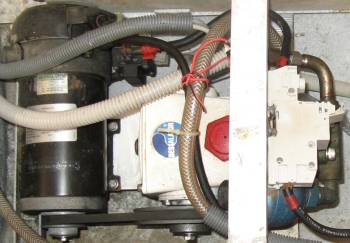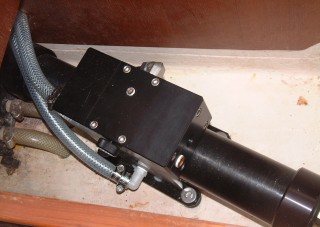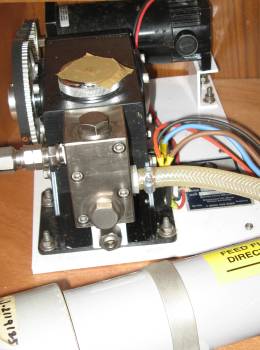Watermakers
When we
cruised in the '80s, watermakers (or desalinators) on private boats were
extremely rare, and usually found only on larger, expensive yachts. But
now many watermaker companies cater to smaller boats. The units are still
fairly expensive to buy and to run so they're still a bit of a luxury item, but
they're much more affordable than they used to be, and several good options are
available depending on your needs. Subjects discussed in this article
include:
Do you really need a watermaker?
(or Why buy a cow when milk is so cheap?  )
)
There are actually very few cruising grounds in the world where you really
need a watermaker. Just about anywhere in the world with a local
population will have potable water somewhere ashore, be in from a tap or sold in
big jugs. It takes a lot of bought water to come up to the
thousands of dollars you'll spend on a watermaker system. So why spend the
money?

Getting non-potable water from a well in Chagos |
One thing a watermaker does is to extend the amount of time you can
spend in places that don't have easily accessible water ashore -- places like the
San Blas Islands
of Panama, the outer islands of the Bahamas, the
Tuamotus of
French Polynesia, isolated atolls in the Pacific,
Chagos Archipelago in the
southern Indian Ocean, and many other beautiful areas that are thinly inhabited
or even totally uninhabited. These are exactly the sorts of places that we
seek out, and we like to spend as much time in them as possible.
Another advantage of a watermaker is that it increases the level of
personal comfort on board: Dishes can be washed in fresh water, clothes can
be washed as often as you wish (and boats with watermakers can often support
having a washing machine), showers can be taken as often as you want --
including each time you come out of the ocean after swimming.
Watermaker water is guaranteed healthy (assuming you've kept up to
industry standards), a great advantage when cruising in places with potentially
iffy water, or where heavy rains can cause run-off to pollute the local water
supply.
Watermakers save you the wear and tear on muscles when the alternative
is to schlep 20 liter jugs of water from shore to the dinghy and then up to the
boat deck. We have a friend who, after wrenching his back and having to
spend a long time lying down to recuperate, wrote on all his water jugs:
"Warning: Carrying water jugs can be hazardous to your Back!"

12v DC motor directly driving a high-pressure pump
This system delivers 60 L/hr but draws 30 amps |
How much water do I really need?
This is another number that varies tremendously between boats. On Ocelot,
with 4 adults all taking fresh water showers (but from a sun-shower, not a
pumped system) and washing our dishes in fresh water, and doing a load of
laundry every few days, we'd go through 400 liters a week, or about 50 liters a
day. Note that nobody goes down below salty - we always rinse off after
swimming, so the upholstery doesn't get clammy. Washing dishes and/or
bodies in salt water, or catching rainwater (which we generally don't do) would
certainly bring that number down. Washing your decks down in fresh water
after a sail, showering with pressure water, doing lots of laundry, or even
doing a lot of scuba diving (and having to rinse the gear afterwards) will push
it up. But 12 liters/person/day (3 gallons/person/day) is probably a good starting point.
How Reverse Osmosis Watermakers Work
Virtually all commercial watermakers use a "Reverse Osmosis" (RO) semi‑permeable
membrane to remove the salt from seawater. This bit of magic is typically
a hollow tube about a meter (39") long and 60 mm (2.5") in diameter, encased in
a high‑pressure housing. Such a membrane is called a 25 40 or even a
2540 (for 2.5" diameter by 40" long). When clean seawater is forced over the outside of
this membrane at a pressure of 40‑60 bar (600‑1000 psi), about 10% of it will go through the
membrane and emerge as drinking water. Magic!
The reason it's called "Reverse Osmosis" is that the salt in seawater has a
natural tendency to flow towards water that has no salt. The "osmotic
pressure" of seawater is about 24 bar (350 psi). By applying a pressure
much higher than the natural osmotic pressure, this tendency is reversed, and
the semi‑permeable membrane allows only the fresh water to pass. If you
want more than this layman's explanation,
Wikipedia
does a pretty good job.
Watermaker Types
Getting seawater up to the pressures necessary for the RO membrane to work
requires a fair amount of energy. Boats with large AC generators can use an AC
motor to drive a high‑pressure pump. Alternatively, the high‑pressure pump
can be belt‑driven off a generator, or even the main engine. This adds a
bit of vibration but if the hoses are long enough this shouldn't present a
problem, and it's one of the more efficient designs. These designs can
produce a lot of water fairly quickly (hundreds of liters an hour).
However, the AC watermakers don't care as much about energy efficiency.
They're far more concerned with money efficiency, producing a reliable unit
cheaply. Therefore, some of them consume a lot of power.
Make sure you check the specs and make sure that your generator has the extra
capacity. We've seen several reports of folks who've installed AC RO
systems only to find that their generators weren't big enough to handle the
motors. (Remember that starting a motor will require
10 times its normal running current.)
Boats that have limited AC power generation capabilities will probably want
to go with a 12v design. The quick-and-dirty approach here is to connect a
really big 12v motor to a high‑pressure pump. Several companies produce
this type of desalinator. It's a relatively cheap approach but the low
liters/amp‑hr ratio mean it's relatively inefficient, so you end up paying
(in energy) in the long run.

The pressure amplifier uses no electricity at all |
A more efficient (but higher initial cost) design uses fairly standard 12v
water pump(s) to produce relatively large volumes of water at relatively low
pressures (4‑8 bar or 60‑120 psi). This water is fed into a
"pressure-amplifier" which converts it to much lower volume but much higher
pressure - typically by a factor of 10:1 each way. This produces the 40‑60
bar (600‑1000 psi) needed to make the RO membrane work. The
efficiency improves because the high
pressure waste water in the membrane housing (the water that did not go through
the membrane) can be used to help power the next stroke of the amplifier, making
the whole system much more efficient, typically producing twice as much water
for the same number of amp‑hours. The "pressure-amplifier" is strictly
a mechanical device and uses no electricity at all.
Spectra Watermakers
are probably the best known company to use this design approach, and they're considered
the Rolls Royce of 12v watermakers. They have a cute
animated graphic of their "Clark Pump" amplifier for those who're
interested.
There are (or were) units available that use no electricity at all, but are
towed behind your boat and are powered by the boat's motion through the water.
Reviews seem to be generally positive, but at least one company's
website doesn't
seem to work anymore, so perhaps they're no longer in business. We have no
direct knowledge of these systems, but given the number of fishing lures we
lose, we'd be a bit hesitant to tow very expensive gear behind Ocelot - it might
be eaten!
In the interests of completeness we should mention that some big ships use
the excess heat and vacuum from their engines to boil seawater, and then they
use cool seawater to condense that steam to produce absolutely pure distilled
water. This technique is also used by big land-based multi-stage "flash
plants", especially in the Middle East, where they're usually located next to
big power-plants so they can use the excess heat from the generators.
However, this is an extremely energy intensive method, suited only to large
installations with lots of excess heat.
Selection Criteria
The first issue is how do you want to power your watermaker? If you've got
a generator then you almost certainly want to use it to drive a high-pressure
"Cat" pump, either directly (via a belt from the engine) or via an AC motor.
Driving your pump directly from the engine is cheaper (since it dispenses with the AC motor) but
it also limits flexibility somewhat. When your generator
breaks down, how will you power your pump? With the more expensive AC
motor option, you can use another AC source if necessary.
There are many more AC watermaker systems available than DC systems, so
you'll have a much larger selection of units to buy. With an AC system,
your selection criteria is probably based on how much water your unit can
produce for a given amount of money. That is, you'll want to maximize
(liters per hour)/cost. Running costs are pretty much the same for most
units, as long as your generator has sufficient capacity to drive the pump as
well as perform its other duties.

Another 12v direct-drive installation
Membrane housing in foreground |
For either AC or DC installations, another decision is to buy a monolithic
system in its own enclosure, or to buy a system that uses separate components
that you can tuck
in where they'll fit better. Most cruising sailboats have limited space for such
add-ons, and watermakers can be pretty big. Distributed systems are
certainly more work to install, but the installation isn't difficult and
they can fit in places a monolithic unit can't. The components you'll have
to mount and plumb together include a seawater strainer, several water valves,
1-3 standard domestic water filters, the membrane in its pressure housing, and
at least one water pump. DC systems will also have to run fairly large cable from
your electrical distribution panel to your motor(s). Possible other
equipment includes a pressure amplifier (if your system uses one), flow meters,
pressure gauges, control panel, pressure accumulator, etc. This may sound
complicated but it actually isn't, and it's a good way to become more familiar
with the components of your watermaker.
For DC systems, there are fewer buying options so fewer decisions. If you're
going to be cruising long-term then you might want to consider the extra
up-front expense to go with a more efficient system using a pressure amplifier.
But if money is tight then perhaps a cheaper direct drive system like the
Katadyne
(who bought Pūr) is better for you.
Katadyne
also makes units that can be powered by hand, which sounds like a useful unit to
have in a life raft or a ditch-bag.
RO Membranes don't last forever, so make sure you ask your manufacturer if
their system uses standard sized membranes (like a 2540), or if they use a
custom membrane that can only be purchased from the manufacture. Standard
sized membranes are manufactured by several companies and are available from a
variety of sources for about $150. Custom membranes often cost 2‑3 times
that much. Our first membrane lasted 6 years but we've heard of them
lasting 10 years.
A fairly crazy alternative
We've heard several people talk about building their own watermaker but I've never actually seen anyone try. There
are several companies selling RO membranes for less than $200. High-pressure membrane housings can also be found
on the web. Then you need a high pressure (Cat) pump and some way to drive it, a pressure regulating valve and
perhaps some instrumentation, like a pressure gauge and perhaps a flow meter. Total cost so far is still less than
$1,000, much less than the $3,000‑$9,000 that you'll spend on a commercial unit.
Installation tips
These will vary with each boat so we can only give generalities here. DC
watermakers use a lot of power and their performance tends to be fairly voltage sensitive.
Make sure your electrical connections can't corrode and that your wires are big enough that
you don't get any significant voltage drops. We put ours under Chris'
bunk, a good 10m (30') from our power panel, so we ran huge wires and soldered
all connections we could. Even going through 3 circuit breakers before it
gets to the motors, we still only lose about 0.3v. We also tend to run the
system when the batteries are at their highest voltage - we watch our
Solar Controller and when it
starts limiting current to the batteries we run the watermaker for an hour or 2.
The components should be as low as possible in your boat - ideally below
water line. This will help keep air from getting into the system and will
also mean that less pressure is lost to lifting the water up. High
pressure pumps generally can't pump if there's air in the system, and getting
air out can be difficult. If your primary pump is too high, you may need a
"lift pump" which costs more in terms of money, electricity, and complexity.
Make sure you install your watermaker somewhere that can take getting wet.
With such high pressures, it's likely that some connections will leak a bit.
You also won't want to put the first 5 minutes of water produced into your tanks
(it often smells a bit of hydrogen sulfide). We save the first few minutes
of water produced in a bucket and usually use it for washing dishes.
Any watermaker makes enough noise that you probably shouldn't run it while
folks are trying to sleep nearby. Ours is fairly silent, but it's right
under a bunk. The motors vibrate a bit and the pressure amplifier clicks
every few seconds as it shifts. But it's only an issue in that cabin.
Testing the water quality
Watermakers generally produce very good quality water, but you should test the
water periodically to make sure that everything's working OK. Do NOT
depend on tasting the water. If you can taste salt, the water is
2‑3 times saltier than is good for you. Seawater usually starts
out at something like 30,000 parts per million (PPM) of Total Dissolved Solids
(TDS: salt, etc). A watermaker should bring that down to 200-500 PPM.
More than 500 PPM is not good for you long term, and can lead to kidney stones
and other unpleasantness. But water doesn't taste salty until it gets up
over 1,000 PPM. A small battery powered TDS meter generally only costs
$10‑30 and is well worth the investment. Many watermaker suppliers
will include a TDS meter when they sell you a unit.

Our watermaker was installed under a bunk,
with the membrane in the bilge and the
pressure amplifier under the step to the bunk. |
Care of your watermaker and components
Watermakers like to be run everyday, if possible. In cooler climates you
can get away with running it less often, but in the tropics you need to at least
flush the system with (un‑chlorinated) fresh water every other day to prevent
growth on the membrane. But if you can't run it for a week or so, you
should "pickle" your system with special preservative. Most units can be
pickled with simple Sodium Metabisulfite, which is commonly available and
much cheaper to buy from a chemical supply house than from the
watermaker manufacturer. But some units, like the Spectra, need special
pickling solution. Un‑pickling your system usually involves running it
unpressurized for about 30 minutes, then pressurizing the system but not using
the water for drinking for another 30 minutes or so.
Growth on the membrane can sometimes be cured with either an alkaline or an
acid wash. Both chemicals can be purchased from your manufacturer.
Mix the chemical up in a bucket of (ideally) hot water, de‑pressurize the
membrane, and place both the input hose and the brine-discharge hose into your
bucket, to create a closed system. Then run the system (unpressurized) for
30‑60 minutes, circulating the chemical solution through the system.
Forcing the chemicals through the membrane will damage it, but running the
system unpressurized will clean the outside of the membrane.
Another maintenance item is the input pre-filters. At the very least,
you should have a 5 micron filter on your water input line. We have an
additional 20 micron filter in front of the 5 micron filter, and it's the
20 micron filter that clogs up the fastest. How fast it clogs depends on
the waters you run your watermaker in. In the open ocean, we can go months
without changing the filters, but coastal cruising usually causes the filters to
get dirty somewhat faster. As a general rule, we like to be able to see
into the water at least 10' (3m) before we'll run our watermaker. If we
can see where our bridle connects to our anchor chain, that's usually good
enough.
RO membranes are very sensitive to chlorine. Make sure that no
chlorinated water gets near the membrane. If you flush your system after
each use (as you should in the tropics) then put an activated charcoal (carbon) filter in
your flush circuit and make sure that you replace that filter at least every
6 months, no matter how little you use it. Better yet, flush only from the
water you produce, and make sure that only watermaker water goes into that tank.
Our watermaker feeds into our port-side tank, so domestic water never goes into that
tank, only into the starboard tank.
What does a watermaker cost?
This is another number that varies tremendously, even with time.
Luckily, the internet allows you to do cost comparison research quickly and
easily. The cheapest commercial systems we've seen cost about $3,000 and
higher output or more efficient systems can cost 2‑3 times as much. We can
say that our Spectra 200C
cost us about $5,000 from
Emerald Harbor Marine
in 2001. It produced about 30 liters (8 US
gallons) per hour in its initial configuration, before we added the second pump
to bring it up to 50 liters/hour.
Spectra
is one of the highest quality and best respected manufacturers of 12vDC
watermakers, and their prices reflect that. In 8 years we've probably
spent another Boat Buck ($1,000) for a new membrane, new pump heads,
pre-filters, pickling and cleaning solutions, and bringing our
pressure-amplifier pump in for routine service once.
Installation costs depend on local labor rates, but unless money is no object
we'd recommend doing the job yourself. It's not difficult and it's a good
way to get to know your system.
Besides energy, running costs are fairly low. AC systems are usually
run when the generator is on to charge batteries so the incremental costs to run
the watermaker aren't a lot. Our unit consumes about 15 amp‑hours/day,
which is about 40% of the output of one of our 120W solar panels.
Pre-filters have to be changed when they get dirty. We usually use the
kind that can be cleaned and reused, although they cost a bit more. The
filter housings can be bought from any hardware store for much less than from a
marine store.
If you won't be using your watermaker for more than a week or so then you'll
need to pickle it, which usually costs about $10 in chemicals.
Our first membrane lasted 6 years, but we've heard of membranes lasting up to
about 10 years. If your membrane is a standard size like a 2540, they're
usually available on the internet for under $500. But some companies use
special custom membranes, forcing you to go to the manufacturer and pay
2‑3 times that much for a replacement membrane.
We don't know how long high-pressure "Cat" pumps last, but we usually have to
replace one of our ShurFlo pump heads every year or so.
What we have on Ocelot
Ocelot is a 12v "battery" boat without a generator set so we needed a
12v solution. We started off with 4 adults on
board, 2 with long hair that needed frequent washing. We also like to go
scuba diving, and scuba gear needs to be rinsed in fresh water every time it's
used. Being an engineer with (at the time) a paying job, I decided to go with the most
efficient design I could find - efficiency in this case being defined as the most
liters of water produced per amp-hour of electricity, not liters/hour/dollar spent.
In 2001, the hands-down leader in this category was the
Spectra 200C.
This unit uses a single 12v pump (actually produced by ShurFlo - their model 8008‑943‑839) working into a
"Clark Pump" pressure amplifier. The specs say that in ideal
conditions it produces 8 US gallons (30 liters) per hour while consuming
only 8 amps, thus yielding an efficiency of
1 gallon (3.7 liters) per amp-hour of electricity. Watermakers
don't produce as well in warm water so we found that
reality in the tropics didn't quite get to this level, but we're usually within
80‑90%. The 200C could also be expanded by adding a second ShurFlo 8008‑943‑839
pump in parallel with the first, which we did by
buying a secondhand pump from another cruiser in Grenada. The second pump
doubles the power consumed (of course) and almost doubles the water output.
So it's not quite as efficient as the single pump design, but the higher
pressure also means that water quality is improved, because the RO
membrane produces better quality water with higher pressure. Unfortunately, the higher pressures of running both
pumps together also causes the pumps to wear out faster. On Ocelot we
have switches that allow us to run either pump singly or both together.

The 4 valve panel is to the left with one pump next to it. The 2 filters
are next to that, with the accumulator to the right of the bilge pump.
The second pump & the carbon flush filter are mounted on the near wall. |
Our installation has not been trouble free, but no watermaker installations
ever are - depend on it! In 2003 the support from
Spectra
was excellent. Our first problem occurred in
French Polynesia, after we'd been using the system for 2 years. Our
pressure amplifier pump started shifting erratically, much faster on one side
than the other, and output plummeted. We emailed Spectra and based on our
symptoms they knew exactly what the problem was - a small "annular ring" inside
our pressure amplifier had cracked. They promptly emailed a quick-fix:
remove the annular ring, reverse it, and replace it. Only the
high-pressure side is prone to cracking so reversing the ring would get us
working again. Of course, this solution worked beautifully, but we weren't
happy having a cracked ring still in the system. So Spectra air freighted
us 4 new annular rings, 2 special removal tools, and a large fist-full of spare
O‑rings, all at their expense. We'd also mentioned that our output had
been slowly dropping over the last year or so, so they included a pair of brand
new pump-heads in their shipment, also at no cost to us. Unfortunately, Glenn, who was responsible for that
excellent service, no longer works at Spectra, so their service has dropped off markedly.
Our first membrane lasted about 6 years but eventually died in the Maldives,
of all difficult places to try to get spares. The symptom was that the
salinity went up. It still removed most of the salt, but instead of
350 ppm, the water was more like 1,300 ppm, good enough for dishes
but not safe to drink long term.
We eventually had a new membrane shipped into the Seychelles. Replacing
the membrane was fairly straightforward: disconnect and remove the membrane
housing, unscrew one end, remove the old membrane, install the new one
(lubricating the seals lightly), screw the end back on, and re-install where it
belongs. The manual that comes with the Spectra details all this (and
more).
Our only real issue with our Spectra is that our (older) model tends to chew
through pump-heads. After about 700 hours (say, 2 years) the pressure and
output drop low enough that we need to replace the pump heads. We've gone
around and around with Spectra on this, and they tend to deny that they have a
problem at all. They used to give us a special deal on new pump-heads
but they no longer do.
But Spectra
has changed their pumps recently (without admitting that their previous pumps had
any problems) replacing the ShurFlo pumps with fancier
vane-pumps. These are more expensive and they consume more electricity so
they're less efficient but apparently they last better. They also
apparently can't be run dry, so Spectra has placed elaborate sensors and control
systems around the pumps in their newer designs. The net result is that
their systems are somewhat more complicated and expensive, but should have better
reliability.
Equipment Pages:
Chart Downloads | Making mbTiles | KAP Files | OpenCPN | Turnbuckles | LEDs | Anchors | Sail Drives | Epoxy Work | AIS | Solar Panels | Watermakers | 3G Modems
Cruising Info:
Up | General Cruising Info | Pacific Ocean Cruising | Indian Ocean Cruising | Provisioning Food & Fuel | Cruising Recipes
Top Level:
Home |
Destinations |
Cruising Info |
Underwater |
Boat Guests |
Ocelot |
Sue |
Jon |
Amanda |
Chris |
Site Map |
Make a Comment
 |
Lifetime
Commodores
of the
Seven Seas
Cruising
Association |
 |
|
If our information is useful,
you can help by making a donation
|
Copyright © 2000‑ Contact:
Jon and Sue Hacking -- HackingFamily.com, svOcelot.com.
All rights reserved.







